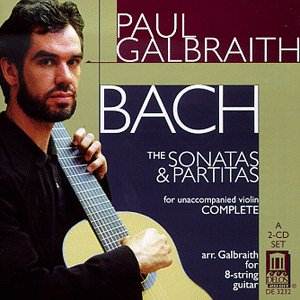Guitarist Paul Galbraith designed an 8-string guitar,
that he had built specially for him, which uses the usual 6 guitar strings
but is augmented by an additional high string and low string. This allows
him to play the instrument in a much wider range than usual; rather
than playing the highest notes further up the neck, where tone is less
clear, he has an additional string for them. The extra low string allows
him to have a much deeper range of bass notes.
In addition, he plays this guitar in a very unique
way - it is supported by a metal endpin, like a cello, and stands on
a wooden resonance box. He holds it in the same way as a cellist holds
his instrument, and plays it almost vertically. Suffice it to say that
this instrument looks surprising at first, but it takes but a few notes
to appreciate its unique sound.
Unique is a work that describes this entire recording.
Paul Galbraith has arranged Bach’s sonatas and partitas for solo violin
to be played on the guitar, as have many other players of plucked instruments
(guitar, lute, theorbo). Yet the range of his instrument allows him
to go much further than other arrangements (he has also change the keys
of four of the suites to best exploit the range of his guitar). The
low notes, such as in the beautiful A minor fugue or in the massive
E minor chaconne, resonate richly, and the higher notes ring clear and
sharp.
Galbraith claims that these works "were conceived
as a single piece, like a ‘suite of suites’". His "personal
impression is that the "6 solo" is an instrumental gospel
story in triptych form, telling of the Birth, Passion and Resurrection
of Christ." Whether or not this is the case, this is by far the
most inspired recording of these works I have ever heard, on any instrument.
His playing flows so smoothly in the slower movements, with the subtlest
phrasing and dynamics, and his tempi - often surprising - shed new light
on these works.
Many of the movements are played far slower than other
performances; the E minor chaconne, at nearly 20 minutes long, is nearly
twice as long as many other renditions. Gone is the hurried sound of
musicians just barely able to keep up with Bach’s hectic score. Instead,
we hear the subtle harmonies and counterpoints that lay hidden in this
extraordinary work. Galbraith gives this, the grandest movement in all
of Bach’s solo works, the approach it needs to become otherworldly,
to transcend mere music. From a virtuoso display of pyrotechnics it
becomes a spiritual meditation; from a mad rush, it becomes a study
in restraint and depth. He adds incredible emotion to this piece, playing
each section at a tempo that allows the ear to appreciate the complexity
of Bach’s music and its profound spiritual intensity.
This is the finest recording of these works for any
plucked instrument, and perhaps for any instrument at all. Galbraith’s
unique style, coupled with the magnificent sound of his guitar, make
this one of the most essential Bach recordings I have ever heard. Buy
this disc for a totally new approach to some of Bach’s finest music.
Kirk McElhearn

![]() Paul Galbraith, 8-string
guitar
Paul Galbraith, 8-string
guitar ![]() DELOS DE 3232 [117.52]
DELOS DE 3232 [117.52]